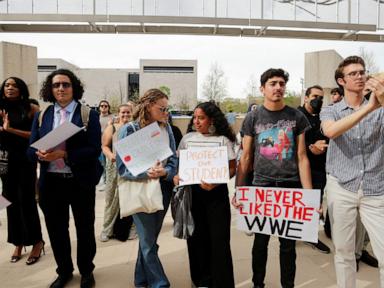Families and students are growing nervous about the fate of the Free Application for Federal Student Aid (FAFSA) amid President Trump's massive cuts to the Department of Education and his plans to do away with it entirely.
FAFSA has had a rough few years, starting with a clumsy rollout of revamped forms during the Biden administration that led to a drop in the college aid applications.
But even amid a need to rebuild trust with parents and applicants, the Trump administration has halved the Department of Education, and the agency has seen multiple high-level retirements, including the retirement this week of the chief operating officer for the Office of Federal Student Aid.
As of March 17, the Education Department marked more than 8 million completed FAFSA forms, an increase of 50 percent from those submitted by the same time last year.
"We have concerns that when students and families hear that the Department of Education is being dismantled or shutting down ... they might hear, and we have concerns that they take that to mean that there won't be a FAFSA, that there won't be a Pell Grant, that as the department goes away, Federal Student Aid goes away,” said Kim Cook, chief executive officer of the National College Attainment Network (NCAN).
“We've been working very hard with our members and the message to our students that even if there is disruption or change, Federal Student Aid, FAFSA, Pell Grants continue,” Cook added.
Students technically have until June 30 to complete the FAFSA forms, and schools are processing the forms they have received so far from the Education Department. But many high schoolers receive college acceptance letters in early spring and have to make a decision on where to go by May 1.
NCAN, which tracks completed FAFSA applications by high school seniors, says that while completions for the 2025-2026 school year are ahead of where they were a year ago, they are still lagging behind the 2023-2024 FAFSA cycle.
Around 42 percent of current high school seniors completed the applications through March 21, significantly better than last year but behind the class of 2023 at this point.
Last year’s FAFSA cycle turned into chaos as the Biden administration attempted to simplify the forms, which determine an individual’s student aid needs and ability to get a Pell Grant.
While a reformed FAFSA application was celebrated, the rollout was shaky. The opening of the application was months behind, and once it was up, glitches prevented many from completing the forms in a timely fashion.
“The Department has been extraordinarily transparent on FAFSA unlike the previous Administration who left hundreds of thousands of students in the dark when the form was down for months,” a spokesperson for the department said.
Colleges last year had to move back their decision days past May 1 due to the delay, and the number of completed applications did not reach that of previous ...










